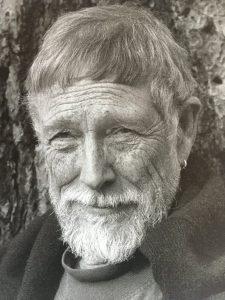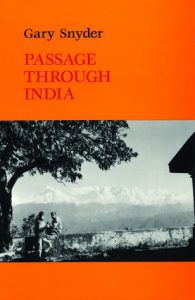by Brian Morris
10th November 2020

There is no simple or direct relationship, as I have long emphasized, between the philosophy (or metaphysics) that a person advocates and the political views they may express. An ecological sensibility has therefore been advocated by people right across the political spectrum, including many fascists (for example, Walter Darre, Martin Heidegger, and Garrett Hardin) (Morris 2014: 193). Likewise modern Buddhists have expressed a diversity of political views, some quite reactionary, others crypto-fascist; most, however, advocating some form of liberal democracy. But in this essay I will discuss the relationship between Buddhism and anarchism and I will do so by specifically focussing on the life and writings of the Zen Buddhist and well-known poet, Gary Snyder.
Described as the “poet laureate of deep ecology”, Gary Snyder was a multi-talented “dharma bum” (as Jack Kerouac famously depicted him), who attempted to integrate many diverse interests and political concerns. Born in San Francisco in 1930, Snyder was a writer and accomplished poet, a Zen Buddhist with a scholarly interest in Chinese and Japanese art and culture, a renowned deep ecologist and environmental activist, and a keen mountaineer, as well as being an anarchist and expressing radical form of left-wing politics (Snyder 1980, Carolan 2016: 31-40).
From his earliest years Snyder developed a profound love of the natural world, an enthusiasm for climbing mountains, and began to write lyrical poetry. During his earlier boyhood Snyder also became aware of the Salish people living nearby on the shores of the Puget Sound. He thus became deeply interested in Native Indian cultures and their relationship to the natural world (Snyder 1980: 93).
In 1947 Snyder won a scholarship to study at Reed College in Oregon. Four years later he graduated with a degree in anthropology and literature, as well as publishing his first poems in a student magazine. He then went to the University of Indiana to continue his studies in anthropology. But, after reading and being inspired by Daisetz Suzuki’s Essays in Zen Buddhism, Snyder abandoned his postgraduate studies in anthropology. Heading south to San Francisco, to “sink or swim as a poet”, in 1953 Snyder enrolled in the Department of Oriental Language at the University of California, Berkeley. There he studied Chinese and Japanese culture and language and became deeply interested in Zen Buddhism.
During the 1950s Snyder was closely associated with the so-called “Beat generation”, becoming a close friend of Kenneth Rexroth, Jack Kerouac, Allen Ginsberg and Philip Whalen, all of whom were deeply interested in both poetry and Buddhism. Rexroth, an older man, and a distinguished scholar, was also an anarchist. In1955 Snyder spent the summer with Kerouac, living in a cabin in Mill Valley, California. In his semi-autobiographical novel The Dharma Bums (1959) Kerouac gave an idealized portrait of Snyder as the character Japhy Ryder. Like his hero the Chinese Ch’an poet Han Shan (circa 8th century) Snyder is described as a poet, an enthusiastic mountain climber, and a Buddhist, dedicated to meditating on the essence of life (Kerouac 1959: 22). But unlike Han Shan, Snyder, according to Kerouac, led a Dionysian life in the 1950s, centred around free love, with naked parties and experimenting with various psychedelic drugs (on Han Shan see Snyder 2009).
In 1956 Snyder went to Japan and for the next twelve years went back and forth between Japan and California, becoming a serious student of Zen Buddhism, although he was never fully ordained.
 In 1962, together with his second wife Joanne Kyger and Allan Ginsberg, Snyder spent four months travelling around Sri Lanka and India, visiting all the pilgrim sites associated with Gotama the Buddha. During his travels Snyder came to meet the German scholar-monk Nyanaponika, as well as the young Dalai lama, who had recently settled in exile at Dharamsala. Two decades later Snyder published a record of his travels as Passage through India (1983).
In 1962, together with his second wife Joanne Kyger and Allan Ginsberg, Snyder spent four months travelling around Sri Lanka and India, visiting all the pilgrim sites associated with Gotama the Buddha. During his travels Snyder came to meet the German scholar-monk Nyanaponika, as well as the young Dalai lama, who had recently settled in exile at Dharamsala. Two decades later Snyder published a record of his travels as Passage through India (1983).
In 1967, Snyder participated in the famous “Gathering of the Tribes” in San Francisco – a large protest against the Vietnam War and the government clamp-down on psychedelic drugs – and that same year married Masa Uehara, whom he had met in Osaka a year earlier. Snyder soon became a father of two sons, Kai and Gen, and around 1970 built a house in the foothills of the Sierra Nevada Mountains in Northern California. There he settled with his family and established a Zen meditation centre.
Throughout his life Snyder published collections of reviews, interviews and short essays, as well as various collections of poetry, the most well-known being Turtle Island (1974) and Mountains and Rivers Without End (1996) (for his essays on Buddhist eco-anarchism see Snyder 1969, 1980, 1990; on his biography and personality see Halper 1991).
In 1985 Snyder became a professor of English at the University of California, Davis, where he now has the status of an emeritus professor. He taught mainly ethno poetics, creative writing and the literature of the wilderness. All his poetry, it is worth noting, celebrates a sense of place and community (Turner 1995: 42, Kaza 2019: 38-52).
It has been widely recognized that Gary Snyder, along with the Norwegian philosopher Arne Naess, was a key inspiration and one of the founders of the Deep Ecology movement that emerged in the 1980s. The classic introduction to Deep Ecology by Bill Devall and George Sessions is dedicated to both men, and it includes as an appendix Snyder’s seminal essay on “Buddhism and the Possibilities of a Planetary Culture” (1985: 251-53). What is interesting about the essay is that it was originally published in 1961 as “Buddhist Anarchism” (in the Journal for the Protection of All Beings). Then, slightly revised, it appeared in Snyder’s collected essays Earth House Hold under the title “Buddhism and the Coming Revolution” (1969: 90-93). The essay gives a succinct account of the Snyder’s radical (anarchist) politics, and has been reprinted in many anthologies relating to Engaged Buddhism (for example, Eppsteiner 1988: 82-85, Kotler 1996: 123-26). It is of interest that the words “anarchism” and “revolution” were both deleted later by the deep ecologists.
 For over fifty years Gary Snyder as a deep ecologist advocated a radical (anarchist) vision that attempted to integrate Zen Buddhism, Native American (or tribal) cultures, and the ecological sciences that had emerged in the late nineteenth century in the wake of Darwin’s evolutionary biology. I will briefly discuss each of these contrasting perspectives in turn.
For over fifty years Gary Snyder as a deep ecologist advocated a radical (anarchist) vision that attempted to integrate Zen Buddhism, Native American (or tribal) cultures, and the ecological sciences that had emerged in the late nineteenth century in the wake of Darwin’s evolutionary biology. I will briefly discuss each of these contrasting perspectives in turn.
1) Zen Buddhism
A strong advocate of ecological Buddhism, Snyder is highly critical of earlier Buddhist philosophy, which he felt, completely failed to analyse the degree to which “ignorance and suffering are caused or encouraged by social factors”. Its major concern had been “psychology”, and it gave scant attention to historical and sociological problems. Although, Snyder writes, Mahayana Buddhism had a grand vision of universal salvation, in fact it largely focussed on developing esoteric systems of meditation designed to liberate a few dedicated monks from “psychological hang-ups and cultural conditioning”. Snyder thus emphasises that throughout its history, Buddhism has largely ignored or accepted the “inequalities and tyrannies of whatever political system it found itself under” (1969: 90). Buddhism and its social institutions, he suggests, have long been “accomplices” of state power (1969: 114). He also contends that ancient Tibet, when twenty five per cent of the male population became monks, had a class structure that involved a form of economic exploitation. Meditating ten hours a day, he wrote, means that “somebody else is growing your food” (1980: 96. See my essay on the politics of Buddhism, Morris 2014: 70-88).
But given the “modern crisis” and the nature of modern life under capitalism, where nation-states deliberately foster craving and fear, and the economy continually stimulates the greed and desires that cannot be satiated, Snyder felt that some kind of radical social change was therefore imperative. He describes the institutions of capitalist modernity – the nation-state and the multinational corporations – as akin to the hungry ghosts (pretas) of Buddhist cosmology. They are, he suggests, literally consuming the natural world – the soil, the forests and all animal life. Indeed Snyder describes the modern state as a “monstrous protection racket” that facilitates capitalist exploitation of the environment (1969: 91).
It is within this context that Snyder advocates the relevance of the Buddhist tradition, with its ethics of compassion and non-violence (ahimsa).It was his youthful love of nature, Snyder recalls, that led him to study East Asian Culture, specifically Zen Buddhism. For the most important single ethical teaching of the Buddhist tradition, he felt, was its emphasis on non-violence towards all of nature (2007: 52). As Snyder wrote:
“The ancient Buddhist teaching of non-harming and respect for all of nature … is an ethical precept we are in greater need of now than ever, as the explosive energy of the modern industrial world pushes relentlessly towards a terminal exploitation of all the resources of the planet”. (2007: 58)
Buddhist teachings were therefore viewed by Snyder as essential in the creation of a non-violent, communist (that is, classless) and ecological society. He famously came to declare: “The mercy of the West has been social revolution; the mercy of the East has been individual insight into the self/void. We need both” (1969: 92).
Throughout his life Snyder practised meditation, but he never claimed to have become “enlightened” in the typical Buddhist sense. Meditation, for Snyder, simply involves experiencing ourselves as “whatever we are”, while Zen meditation – zazen – is a “way to be” (1980: 97). But he emphasizes the virtues of Zen Buddhism, in that the monks did not engage in begging for alms, but rather grew their own food and undertook physical work (1980: 105). What Buddhist teaching had to offer, Snyder contends, was a “practical method” for “clearing one’s mind of the trivia, prejudices and fake values” that we unconsciously acquire living within the milieu of capitalist modernity (1969: 112).
2) Native American Culture
During his boyhood days Snyder came into contact with the Salish people of the Puget Sound, as well as meeting other Native Americans when he was engaged in logging and in other forestry work in the Cascade Mountains. He thus came to recognize that it was possible to be a hunter or a fisher while also having a spiritual (ethical) attitude towards the natural world – one that expressed non-violence and a deep gratitude to other life-forms (2007: 67). He recognized that there was no radical conflict between the Buddhist ethic of non-violence (ahimsa) and the subsistence practices of the Native Americans and other tribal peoples, and that taking the ahimsa doctrine too literally “leaves out the life of the world” (2007: 69). Snyder also came to recognize that both tribal people and peasant farmers are “people of the land”, which implies in fact that “we are all natives to this earth” (2007: 98).
Having studied anthropology at Reed College in Oregon, Snyder came to form close friendships with anthropologists like Dell Hymes and Stanley Diamond, whose seminal book In Search of the Primitive (1974) offers a searching critique of civilization. This book undoubtedly made a deep impression upon Snyder, and he often cites Diamond, who was a radical enlightenment thinker.
As a critical anthropologist himself Snyder came to extol many aspects of native American culture; for example, the spiritual equality that was generally expressed towards other life-forms, in describing plants and animals as “people” or as kinfolk; the theriomorphism that tribal people expressed in both hunting and in their rituals, whereby they envisage how other animals felt and thought – insights, of course, based on a deep empirical knowledge of the natural world and its wildlife denizens (1974: 109).
As a close friend of Allen Ginsberg, as well as being closely associated with the psychedelic revolution of the 1960s (Osto 2016), Snyder expressed a fascination with the various psychotropic plants – peyote, jimson-weed, as well as psilocybin mushrooms – that were used by Native Americans in their vision quests or Shamanistic rituals. Indeed, he thought there was a “karmic” connection between the peyote cult of some Native American people and the discovery of LSD, suggesting that they both have a “curious way of tuning people into the local soil” (1969: 107). This is debatable, but Snyder made a clear distinction between ecstatic religion and spirit rituals, and a deeper ecological relationship that Native Americans and tribal people generally have towards the world. This level of experience, or ecological sensibility, is what Snyder felt he tried to describe in his own poetry. As he expressed it:
“There are poets who claim that their poems are made to show the world through the prism of language. Their project is worthy. There is also the work of seeing the world without any prism of language and to bring that seeing into language”.
 This is what Snyder attempted to do in his poetry – which focuses specifically on the natural world – rivers, mountains, rocks, trees, flowers, coyotes, woodpeckers and the geology of the landscape (Snyder 1974, 1996). According to some Buddhists all these are merely “illusions” or simply “constructs” of the human mind. Snyder as an empirical realist clearly thought otherwise.
This is what Snyder attempted to do in his poetry – which focuses specifically on the natural world – rivers, mountains, rocks, trees, flowers, coyotes, woodpeckers and the geology of the landscape (Snyder 1974, 1996). According to some Buddhists all these are merely “illusions” or simply “constructs” of the human mind. Snyder as an empirical realist clearly thought otherwise.
Although a critic of civilization, and especially of industrial capitalism, Snyder was not an anarcho-primitivist like John Zerzan and other green anarchists. He never envisaged a return to tribal life and freely admitted at his own home in the foothills of the Sierra Nevada Mountains, he had a four-wheel pickup truck, solar panels and used a laptop computer (2007: 82). What he felt, as an anthropologist, was the “idea that perhaps civilization has something to learn from the primitive”, that is, from the cultural values of tribal people (1969: 120). This echoed Stanley Diamond’s emphasis that enlightenment involved plunging “into the past to develop a more viable sense of the future” (1974: 219). Indeed, Snyder used the term “tribe” to suggest a new type of society that was emerging within industrial nations, one that implied that a “back to the land” movement, and a synthesis of Gandhian “village anarchism” and the syndicalism of the Industrial Workers of the World. This new society would draw on the insights of both cultural anthropology and the most advanced developments of modern science, specifically that of ecology. For Snyder had concluded in the 1960s that nationalism, warfare, heavy industry and consumerism were “already outdated and useless” (1969: 116).
Although Snyder had spent many weeks working in the National Parks as a fire-warden he gradually came to realise that Native Americans had long employed fire to manage their environment, and that fire itself was not purely destructive. In fact, many tree-species, he came to realize, are fire-adapted, and do not reproduce until after fire. He therefore came to understand and advocate that the ecological health of the forests of California (especially) depended in part on “periodic low-level fires” (2007: 3). To avoid the catastrophic fires that periodically occur in the Californian forests, causing immense damage to both life and property, Snyder suggests that we learn from the Native Americans, and start “lots of little fires each year”. This also helps to maintain the “ecological health” of the forests (Snyder 2007: 3-8).
3) Ecological Humanism
The rise of the ecology movement ran parallel with, and was a critical response to, the development and expansion of global capitalism after the Second World War. As both Commoner and Bookchin emphasized, the ecological crisis specifically had its “roots in” the capitalist system as it plundered the earth during this period in its search for profits (Morris 2014: 191-92). What is now described as the “age of ecology” and the “Anthropocene” both refer to the same period – the last seventy years (Radkau 2014, Angus 2016).
Gary Snyder was one of the pioneers of the ecology movement, and long before ecology became a “worldwide fad”, he was writing about an ecological aesthetic; a blending of American Indian and Zen Buddhist philosophical worldviews that put a stress on co-operation with, rather than the conquest of nature (Rexroth 1987: 273). In 1964 Snyder drafted a short essay entitled “Four Changes”. It was essentially an ecological manifesto. Unfortunately Snyder followed Paul Ehrlich, Anne Naess and other deep ecologists in embracing a neo-Malthusian theory that viewed humans as virtually parasites on earth, thus calling for an immediate and drastic reduction of the human population. This implied treating humanity as an undifferentiated entity, completely obscuring the real causes of the ecological crisis, namely global capitalism. Peasant farmers in Africa are certainly not to blame for the ecological crisis, and as one scholar has insisted, even if the poorest three billion of the world’s population somehow disappeared tomorrow – as Snyder envisaged – there would be virtually NO reduction in the on-going environmental destruction, or in the pillaging of the earth under capitalism (Angus 2016: 112. For a strident but insightful critique of the “population bombers”, though not mentioning Snyder, see Bookchin 1995: 59-85).
 The two other environmental concerns that Snyder highlighted in his manifesto were the widespread pollution of the earth – the soils, waters and atmosphere – and the over-consumption of resources under industrial capitalism. Drawing on the ecological sciences, Snyder emphasizes that humans are “but a part of the fabric of life – dependent on the whole fabric for [their] very existence”. He also stresses that “everything that lives eats food, and is food in turn”, and that humans depend for their very existence on “a vast and delicate pyramid of energy-transformations”. Snyder therefore advocates that humans must respect the integrity and intrinsic value of other life-forms, while acting as a “gentle steward of the earth’s community of beings”. He emphasized that:
The two other environmental concerns that Snyder highlighted in his manifesto were the widespread pollution of the earth – the soils, waters and atmosphere – and the over-consumption of resources under industrial capitalism. Drawing on the ecological sciences, Snyder emphasizes that humans are “but a part of the fabric of life – dependent on the whole fabric for [their] very existence”. He also stresses that “everything that lives eats food, and is food in turn”, and that humans depend for their very existence on “a vast and delicate pyramid of energy-transformations”. Snyder therefore advocates that humans must respect the integrity and intrinsic value of other life-forms, while acting as a “gentle steward of the earth’s community of beings”. He emphasized that:
“To grossly use more than you need, to destroy, is biologically unsound. Much of the production and consumption of modern societies is not necessary or conducive to spiritual or cultural growth, let alone survival, and is behind much greed and envy, old age causes of social and international discord”. (1974: 97)
What Snyder thus came to advocate was the need to create an ecologically-aware scientific spiritual (ethical) culture; one that puts an emphasis not on greed, competition and egoism, but rather on harmony, balance, sharing, humility and simplicity. Do not shoot a deer, he writes, “if you do not know how to use all the meat (or) tan the hide and use the leather”. For Snyder being a Zen Buddhist did not imply being a vegetarian. He thus concluded that there was a need in our actions: “To live lightly on the earth, to be aware and alive, to be free of egotism [and] to be in contact with animals and plants” (1974: 99).
What was important about western culture, according to Snyder, was the development of a historical perspective, the awareness that human societies are neither natural nor divine, but historical systems (1980: 101). Thus nation-states are arbitrary formations. As he put it: the political anarchist position is: “that boundaries drawn by national states … do not represent any sort of real entity” (1980: 24). Emphasizing the importance of a “sense of place” and the fundamental links between a human community and the natural world, Snyder stresses the importance of the concept of “bioregion” and the need to develop a bioregional ethic (1980: 138, Drengson and Inoue 1995:67). As he writes: “The aim of bioregionalism is to help our human cultural, political and social structures harmonize with natural systems” (1990: 13).
It is worth noting that Snyder always identified himself with the working class, and in complete contrast to early Buddhism emphasized the importance of human labour. As he wrote:
“There is a triple alienation when you try to avoid work: first, you’re trying to get outside energy sources/resources to do it for you; second, you no longer know what your own body can do, where your food and water come from; third, you lose the capacity to discover the unity of mind and body via your work”. (1980: 103)
However, as a radical strategy, Snyder, in glorious eclectic fashion, came to the following conclusion:
“Let there be encouraged Gnostics, hip Marxists, Teilhard de Chardin Catholics, Druids, Taoists, biologists, witches, Yogins, Quakers, Sufi, Tibetans, Zens, Shamans, Bushmen American Indians, Polynesians, anarchists, alchemists; the list is long”. (1974: 100)
Conflating an ecological worldview with such a motley collection of religious mystics is hardly enlightening. But then Snyder goes on to suggest the need for a “new definition of humanism”, one that would embrace other life forms and express an ecological conscience (1974: 106).
Some two decades later Snyder gave a talk in which he emphasized that the environmental movement in the United States had become split into two distinct and opposing factions. On the one hand, there were the radical environmentalists associated with the Sierra Club who sought the preservation of wilderness areas as icons of pristine nature. They were, Snyder felt, oblivious to the plight of indigenous people and the needs of peasant communities. On the other hand there were the environmental biologists who stressed that human agency had long transformed the natural world, and that there were no “natural” landscapes left. Regrettably, according to Snyder, such biologists had joined forces with the World Bank and various capitalist corporations and agencies, to facilitate the continuing exploitation of nature simply as a resource, and its continuing degradation.
In contrast to both extremes Snyder advocated the need for a “pan humanism” that recognized the needs of both humans and the natural world – a “humanistic scholarship that embraces the non-human (1995: 454-55). Snyder seems unaware, or simply ignores the fact, that such a humanistic ecology had already been expressed in an earlier decade by such scholars as Lewis Mumford (organic philosophy), Barry Commoner (eco-Marxism), Rene Dubos (ecological humanism) and Murray Bookchin (social ecology) (Morris 2012, 2014). But Snyder’s vision of a “coming revolution” is perhaps best expressed in the concluding words to his “Buddhist Anarchism” essay: Suggesting that we must link with the most creative aspects of our archaic past, he writes:
“If we are lucky we may eventually arrive at a totally integrated world culture with matrilineal descent, free-form marriage, natural credit communist economy, less industry, far less population and lots more national parks”. (1969: 93)
Snyder described himself in these words: “I am a poet. My teachers are other poets, American Indians, and a few Buddhist priests in Japan” (1974: 106). But it is clear that Buddhism was only one aspect of Snyder’s ecological philosophy, and that he drew much of his inspiration, as well as ideas, from the anthropological and ecological sciences. As he indicated: the biological ecological sciences have been laying out – if only implicitly – a spiritual (ethical) dimension, and that both the ecological and anthropological sciences are at the “forefront” in the development of a new ecological humanism (1980: 130, 1995, Drengson and Inoue 1995: 71).

References
Angus, I. (2016), Facing the Anthropocene: Fossil capitalism and the Crisis of the Earth System, New York: Monthly Review Press.
Bookchin, M. (1995), Re-enchanting Humanity: A Defence of the Human Spirit against antihumanism, misanthropy, mysticism and primitivism, London: Cassell.
Carolan, T. (2016), New World Dharma: Interviews and Encounters with Buddhist teachers, writers and leaders, Albany: State University of New York Press.
Devall, B. and G. Sessions (1985), Deep Ecology: Living as if Nature Mattered, Salt Lake City: Peregrine Smith Books.
Diamond, S. (1974), In Search of the Primitive: A Critique of Civilization, New Brunswick: Transaction Books.
Drengson, A. and Y. Inoue (eds) (1995), The Deep Ecology Movement: An Introduction Anthology, Berkeley, CA: North Atlantic Books.
Eppsteiner, F. (ed.) (1988), The Path of Compassion: Writings on Socially Engaged Buddhism, Berkeley, CA: Parallax Press.
Halper, J. (ed.) (1991), Gary Snyder: Dimensions of a Life, San Francisco: Sierra Book Club.
Kaza, S. (2019), Green Buddhism: Practice and Compassionate Action in Uncertain Times, Boulder: Shambhala.
Kerouac, J. (1959), The Dharma Bums [2007 edition], London: Penguin Books.
Kotler, A. (ed.) (1996), Engaged Buddhist Reader, Berkeley, CA: Parallax Press.
Morris, B. (2012), Pioneers of Ecological Humanism, Brighton: Book Guild.
Morris, B. (2014), Anthropology, Ecology and Anarchism: A Reader, Oakland, CA: PM Press.
Osto, D. (2016), Altered States: Buddhism and Psychedelic Spirituality in America, New York: Columbia University Press.
Radkau, J. (2014), The Age of Ecology: A Global History, Cambridge: Polity Press.
Rexroth, J. (1987), World Outside the Window: Selected Essays, New York: New Directions.
Snyder, G. (1969), Earth House Hold, New York: New Directions.
Snyder, G. (1974), Turtle Island, New York: New Directions.
Snyder, G. (1980), The Real Work: Interview and Talks 1964-1979, New York: New Directions.
Snyder, G. (1983), Passage Through India [2007 edition], Emeryville: Shoemaker and Hoard.
Snyder, G. (1990), The Practice of the Wild, Berkeley, CA: Counterpoint.
Snyder, G. (1995), “The Rediscovery of Turtle Island” in G. Sessions (ed.) Deep Ecology for the Twenty First Century, Boston: Shambhala, pp. 454-462.
Snyder, G. (1995), “Ecology, Place and the Awakening of Compassion” in A. Drengson and Y. Inoue (eds) The Deep Ecology Movement: An Introductory Anthology, Berkeley, CA: North Atlantic Books, pp. 237-241.
Snyder, G. (1996), Mountains and Rivers Without End, Washington DC: Counterpoint.
Snyder, G. (2007), Back on Fire: Essays, Emeryville: Shoemaker and Hoard.
Snyder, G. (2009) [first published 1959], Riprap and Cold Mountain Poems, Berkeley, CA: Counterpoint.
Turner, J. (1995), “Gary Snyder and the Practice of the Wild” in G. Sessions (ed.) Deep Ecology for the Twenty First Century, Boston: Shambhala, pp. 41-46.
